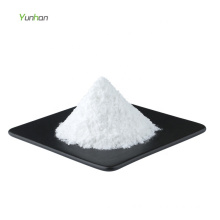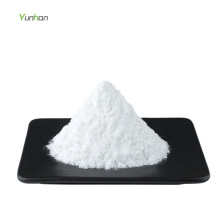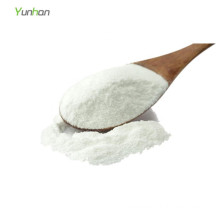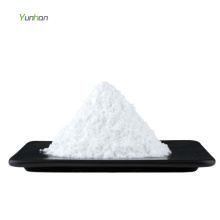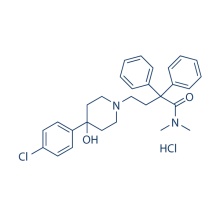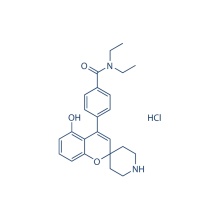ADL5859 HCl 850173-95-4
Product Description
.cp_wz table {border-top: 1px solid #ccc;border-left:1px solid #ccc; } .cp_wz table td{border-right: 1px solid #ccc; border-bottom: 1px solid #ccc; padding: 5px 0px 0px 5px;} .cp_wz table th {border-right: 1px solid #ccc;border-bottom: 1px solid #ccc; padding: 5px 0px 0px 5px;}
Molecular Weight: 428.95 ADL5859 HCl is a δ-opioid receptor agonist with Ki of 0.8 nM, selectivity against opioid receptor κ, μ, and weak inhibitory activity at the hERG channel. Phase 2.
ADL5859 agonizes δ-opioid receptor with a 1000-fold selectivity than µ- or κ-opioid receptor with Ki of 32 nM and 37 nM, respectively.ADL5859 displays weak inhibitory
activity at the hERG channel with an IC50 of 78 μM. The EC50 of ADL5859
against δ opioid receptor is 20 nM.
At
the screening dose of 3 mg/kg p.o., ADL5859 produces 100% reversal of
hyperalgesia in the inflamed paw. The oral ED50 of ADL5859 in the FCA
mechanical hyperalgesia assay is 1.4 mg/kg. The antihyperalgesia
produced by ADL5859 (3 mg/kg, p.o.) is reversed by pretreatment with the
δ opioid antagonist naltrindole (0.3 mg/kg s.c.), thus demonstrating a δ
receptor mediated effect.In the rat forced swim assay, ADL5859 (3 mg/kg
p.o.) produces robust antidepressant-like activity, as evidenced by a
significant decrease in the time spent immobile and a significant
increase in the time spent swimming. The bioavailability of ADL5859 (3
mg/kg p.o.) in rats and dogs is 33% and 66%, respectively.ADL5859
efficiently reduces inflammatory and neuropathic pain mainly by
recruiting δ-opioid receptors expressed by peripheral Nav1.8-expressing
neurons.
Protocol(Only for Reference)
Cell Assay: [1]
Animal Study: [2]
Conversion of different model animals based on BSA (Value based on data from FDA Draft Guidelines)
For example, to modify the dose of resveratrol used for a mouse (22.4 mg/kg) to a dose based on the BSA for a rat, multiply 22.4 mg/kg by the Km factor for a mouse and then divide by the Km factor for a rat. This calculation results in a rat equivalent dose for resveratrol of 11.2 mg/kg.
Chemical Information
Molarity Calculator
Dilution Calculator
Molecular Weight Calculator
Contact us if you need more details on 850173-95-4 ADL5859 HCl. We are ready to answer your questions on packaging, logistics, certification or any other aspects about 850173-95-4、ADL5859 HCl 850173-95-4. If these products fail to match your need, please contact us and we would like to provide relevant information.
Molecular Weight: 428.95 ADL5859 HCl is a δ-opioid receptor agonist with Ki of 0.8 nM, selectivity against opioid receptor κ, μ, and weak inhibitory activity at the hERG channel. Phase 2.
ADL5859 agonizes δ-opioid receptor with a 1000-fold selectivity than µ- or κ-opioid receptor with Ki of 32 nM and 37 nM, respectively.ADL5859 displays weak inhibitory
activity at the hERG channel with an IC50 of 78 μM. The EC50 of ADL5859
against δ opioid receptor is 20 nM.
At
the screening dose of 3 mg/kg p.o., ADL5859 produces 100% reversal of
hyperalgesia in the inflamed paw. The oral ED50 of ADL5859 in the FCA
mechanical hyperalgesia assay is 1.4 mg/kg. The antihyperalgesia
produced by ADL5859 (3 mg/kg, p.o.) is reversed by pretreatment with the
δ opioid antagonist naltrindole (0.3 mg/kg s.c.), thus demonstrating a δ
receptor mediated effect.In the rat forced swim assay, ADL5859 (3 mg/kg
p.o.) produces robust antidepressant-like activity, as evidenced by a
significant decrease in the time spent immobile and a significant
increase in the time spent swimming. The bioavailability of ADL5859 (3
mg/kg p.o.) in rats and dogs is 33% and 66%, respectively.ADL5859
efficiently reduces inflammatory and neuropathic pain mainly by
recruiting δ-opioid receptors expressed by peripheral Nav1.8-expressing
neurons.
Protocol(Only for Reference)
Cell Assay: [1]
| Cell lines | Chinese hamster ovary (CHO) cells stably expressing human κ, μ, or δ opioid receptors |
|---|---|
| Concentrations | 0 nM-10 nM |
| Incubation Time | 60 minutes |
| Method | Membrane preparations from Chinese hamster ovary (CHO) cells stably expressing human κ, μ, or δ opioid receptors are prepared. The assay buffer used is composed of 50 mMtris(hydroxymethyl) aminomethaneHCl, pH 7.8, 1.0 mM ethylene glycol bis(β-aminoethyl ether)-N,N,N',N'-tetraacetic acid (EGTA free acid), 5.0 mM MgCl2 10 mg/L leupeptin, 10 mg/L pepstatin A, 200 mg/L bacitracin, and 0.5 mg/L aprotinin. After dilution in assay buffer and homogenization in a Polytron homogenizer for 30 seconds, membrane Proteins (10-80 μg) in 250 μL of assay buffer are added to mixtures containing ADL5859 and [3H]diprenorphine (0.5-1.0 nM, 25000-50000 dpm) in 250 μL of assay buffer in 96-well deep-well polystyrene titer plates and incubated at room temperature for 60 minutes. Reactions are terminated by vacuum filtration with a Brandel MPXR-96T harvester through GF/B filters that have been pretreated with a solution of 0.5% polyethylenimine and 0.1% bovine serum albumin for at least 1 hour. The filters arewashed four times with 1.0 mL each of ice-cold 50 mM Tris-HCl, pH 7.8, and 30 μL of Microscint-20 is added to each filter. Radioactivity on the filters is determined by scintillation spectrometry in a Packard TopCount. [3H]Diprenorphine with a specific activity of 50 Ci/mmolisused. The Kd values for [3H]diprenorphine binding are 0.33 nM for the κ and μ receptors and 0.26 nM for the δ receptor. Receptor expression levels, determined as Bmax values from Scatchard analyses, are 4400, 4700, and 2100 fmol/mg of protein for the κ, μ, and δ receptors, respectively. Preliminary experiments are performed to show that no specific binding is lost during the wash of the filters, that binding achieved equilibrium within the incubation time and remained at equilibrium for at least an additional 60 minutes, and that binding is linear with regard to protein concentration. Nonspecific binding, determined in the presence of 10 μM unlabeled naloxone, is less than 10% of total binding. Protein is quantified by the method of Bradford. The data from competition experiments are fit by nonlinear regression analysis with the program Prism using the four-parameter equation for one-site competition, and Ki values are subsequently calculated from EC50 values by the Cheng-Prusoff equation. |
Animal Study: [2]
| Animal Models | Nav1.8-cKO mice, CMV-KO mice, C57BL6/J × SV129Pas mice | ||
|---|---|---|---|
| Formulation | 0.5% hydroxypropyl methylcellulose/0.1% Tween 80 | ||
| Dosages | 10 mg/kg - 300 mg/kg | ||
| Administration | Administered via p.o. | ||
| Solubility | 0.5% hydroxyethyl cellulose/0.1% Tween 80, 30 mg/mL | ||
| * Please note that Selleck tests the solubility of all compounds in-house, and the actual solubility may differ slightly from published values. This is normal and is due to slight batch-to-batch variations. | |||
Conversion of different model animals based on BSA (Value based on data from FDA Draft Guidelines)
| Species | Baboon | Dog | Monkey | Rabbit | Guinea pig | Rat | Hamster | Mouse |
| Weight (kg) | 12 | 10 | 3 | 1.8 | 0.4 | 0.15 | 0.08 | 0.02 |
| Body Surface Area (m2) | 0.6 | 0.5 | 0.24 | 0.15 | 0.05 | 0.025 | 0.02 | 0.007 |
| Km factor | 20 | 20 | 12 | 12 | 8 | 6 | 5 | 3 |
| Animal A (mg/kg) = Animal B (mg/kg) multiplied by | Animal B Km |
| Animal A Km |
For example, to modify the dose of resveratrol used for a mouse (22.4 mg/kg) to a dose based on the BSA for a rat, multiply 22.4 mg/kg by the Km factor for a mouse and then divide by the Km factor for a rat. This calculation results in a rat equivalent dose for resveratrol of 11.2 mg/kg.
| Rat dose (mg/kg) = mouse dose (22.4 mg/kg) × | mouse Km(3) | = 11.2 mg/kg |
| rat Km(6) |
Chemical Information
| Molecular Weight (MW) | 428.95 |
|---|---|
| Formula | C24H28N2O3.HCl |
| CAS No. | 850173-95-4 |
| Storage | 3 years -20℃Powder |
|---|---|
| 6 months-80℃in solvent (DMSO, water, etc.) | |
| Synonyms | |
| Solubility (25°C) * | In vitro | DMSO | 86 mg/mL (200.48 mM) |
|---|---|---|---|
| Water | 5 mg/mL (11.65 mM) | ||
| Ethanol | 1 mg/mL (2.33 mM) | ||
| In vivo | 0.5% hydroxyethyl cellulose/0.1% Tween 80 | 30 mg/mL | |
| * <1 mg/ml means slightly soluble or insoluble. * Please note that Selleck tests the solubility of all compounds in-house, and the actual solubility may differ slightly from published values. This is normal and is due to slight batch-to-batch variations. | |||
| Chemical Name | Benzamide, N,N-diethyl-4-(5-hydroxyspiro[2H-1-benzopyran-2,4'-piperidin]-4-yl)-, hydrochloride (1:1) |
|---|
Molarity Calculator
Dilution Calculator
Molecular Weight Calculator
Contact us if you need more details on 850173-95-4 ADL5859 HCl. We are ready to answer your questions on packaging, logistics, certification or any other aspects about 850173-95-4、ADL5859 HCl 850173-95-4. If these products fail to match your need, please contact us and we would like to provide relevant information.
Product Categories : Neuronal Signaling > Opioid Receptor Inhibitor
Other Products
Hot Products
Astragaloside AChlortetracycline HCl 64-72-2Paclitaxel 33069-62-4Dexamethasone Acetate 1177-87-3Dinaciclib (SCH727965) 779353-01-4CHIR-124 405168-58-3Ro3280 1062243-51-9TAME 901-47-3CCG-1423 285986-88-110058-F4 403811-55-2Dabigatran (BIBR 953) 211914-51-1H 89 2HCl 130964-39-5T0901317 293754-55-9Aprepitant 170729-80-3Turofexorate Isopropyl (XL335) 629664-81-9BMS-378806 357263-13-9

